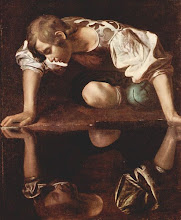 Despite his key role in drama, the story of Tiresias has not really proved inspirational to artists. He puts in a rare appearance in this picture from a private collection, which links Tiresias's story to the next story, that of Echo and Narcissus with a prophesy of Narcissus's fate. The stories of Echo and Narcissus were originally two separate stories, which Ovid, as far as we know, was the first to combine. (public domain picture of narcissi by bormaniuss via wikipedia)
Despite his key role in drama, the story of Tiresias has not really proved inspirational to artists. He puts in a rare appearance in this picture from a private collection, which links Tiresias's story to the next story, that of Echo and Narcissus with a prophesy of Narcissus's fate. The stories of Echo and Narcissus were originally two separate stories, which Ovid, as far as we know, was the first to combine. (public domain picture of narcissi by bormaniuss via wikipedia)Echo was a nymph who covered for Jupiter on one of his amorous forays by distracting Juno with her chatter. As a punishment Juno condemned her to only be able to repeat the last words anyone said. Echo fell in love with the handsome Narcissus, who spurned her, and all the others (male and female) who desired him. One rejected lover cursed him, wishing that he would fall in love with someone unobtainable. When Narcissus saw his reflection in a lake, he fell in love but was unable to reach this bewitching figure. Unable to leave the image of his love, Narcissus died and was changed into the flower that bears his name. Echo also wasted away so that only her voice, still repeating people's last words, is heard in lonely places.

Our first two pictures show Narcissus by himself. The above 1595 picture of Narcissus by Caravaggio is now in Rome's Galleria Borghese. For some reason it is only on the Italian version of the site, and not on the English version. Jacob Pynas painted a Mountain Landscape with Narcissus in 1628, now in London's National Gallery. (public domain picture via wikicommons)


Poussin painted two versions of the story, the earlier (above left) from around 1630 is now in the Louvre, while the later (above right) is in Dresden's Gemäldegalerie Alte Meister (use Narziss as the search item in the box marked Volltextsuche in der Motivliste. Why they don't allow direct links I don't know). At about the same time Claude Lorrain painted a Landscape with Narcissus and Echo, now in London's National Gallery. (public domain pictures via wikipedia)

Turner's picture of Narcissus and Echo (now in London's Tate Gallery) was painted in 1805, while a year earlier the American painter Benjamin West painted the above painting (now in a private collection). (public domain picture via Museum Syndicate)

This 1881 picture of Narcissus by Benczúr Gyula is now in Budapest's Magyar Nemzeti Galéria, but does not appear to be on their website. (public domain picture via wikicommons)

Perhaps one of the most popular paintings of Echo and Narcissus, the above picture by John William Waterhouse was painted in 1903 and is now in Liverpool's Walker Art Gallery. A site devoted to Waterhouse has an article on the models who posed for the picture. Almost as popular is Salvador Dali's Metamorphosis of Narcissus, painted in 1937 and now in London's Tate Gallery.(picture courtesy of WebMuseum under Creative Commons 3.0 licence)
Contemporary artists who have treated the theme of Echo and Narcissus are Steve Leblanc and Richard Baxter, and the pavement artist Kurt Wenner (check out Kurt Wenner's other paintings, including this fine Actaeon).
In the performing arts, Guillaume Apollinaire wrote Les Mamelles de Tirésias in 1903, though it was not performed until 1917. Poulenc wrote an opera based on Apollinaire's Les Mamelles de Tirésias during the Second World War and it was first performed in 1947. In 1951 Constant Lambert's ballet about Tiresias was first performed.
Gluck wrote an opera on Echo and Narcissus in 1779. YouTube has an aria. YouTube also has a pas de deux called Echo and Narcissus, though only the dancers are named, not the composer. I'm no expert but I certainly don't think it's the Lambert one. There are the usual kids in bedsheets dramatisations, and this rather nice short film called "An Echo of Narcissus", though Echo doesn't seem to appear.





No comments:
Post a Comment